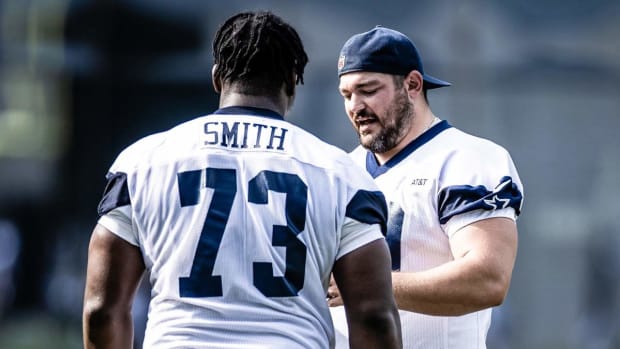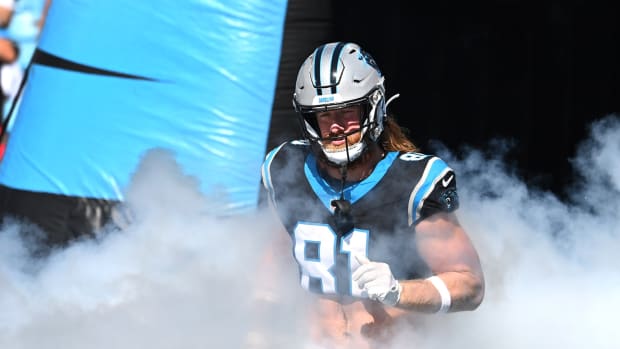How the Janet Jackson halftime show aftermath changed the Super Bowl
As part of our countdown to Super Bowl 50, SI.com is rolling out a series focusing on the overlooked, forgotten or just plain strange history of football's biggest game. From commercials to Super Bowl parties, we'll cover it all, with new stories published every week here.
They remember Justin Timberlake snatching away a swatch of Janet Jackson’s bustier and bra, then standing there for a moment, oaf-like, deserted by his customary savoir faire. They recall her covering her right breast with mortification that may or may not have been manufactured.
But people tend to forget that the contest eclipsed by Nipplegate was one of the most thrilling in the history of the Big Game. Super Bowl XXXVIII featured six scores in the fourth quarter, three in the final three minutes, with Adam Vinatieri’s 41-yard field goal with four seconds to play lifting the Patriots over the Panthers.
It is only dimly remembered, also, that the second-half kickoff was delayed by Mark Roberts, a serial streaker who had previously aired his wares at Wimbledon, the Tour de France, the Royal Ascot horse race (in full view of the Queen of England and the Prince of Wales) and—most daringly—the Running of the Bulls in Pamplona, Spain. Clad in a tear-away referee’s outfit, Roberts sneaked out of the stands at Houston’s Reliant Stadium, past security guards and onto the field, where he disrobed, then performed an Irish jig before being leveled by Patriots linebacker Matt Chatham. Magic Markered onto his back, below the words SUPER BOWEL, was the name of a gambling website, whose officials grumbled afterward that their guerilla marketing coup had been undercut by the surprise celebrity nudity immediately preceding it.
Widely forgotten is the fact that the offending boob—Jackson’s breast, not Timberlake—appeared on camera for just 9/16 of a second. While it was not completely apparent during that blink-and-you-missed-it moment, most of her areola was covered by a sun-shaped “nipple-embracer.” Neither that partial coverage nor the fleeting nature of its exposure to TV viewers (of whom there were upwards of 143 million that day) could prevent the cultural convulsions that ensued.
• LONGFORM: Behind the best—and worst—Super Bowl halftime moments
Likewise, many people have scant recollection of the undercard halftime scandal that preceded the Jackson-Timberlake main event. Before Timberlake’s bodice-ripping—which was supposed to remove the bustier but leave the red lace bra, a Jackson flack explained afterward—the duo was preceded on stage by, among others, Kid Rock, who treated the world to such timeless lyrics as “Bawitdaba da bang a dang diggy diggy diggy said the boogy” while clad in a kind of serape fashioned from an American flag.
Among the patriots displeased by this shoddy treatment of Old Glory was then-Vice Chairman of the Joint Chiefs of Staff Peter Pace, a Marine Corps general who happened to be watching the show in the suite of NFL commissioner Paul Tagliabue. So the commish was already out of sorts when Jim Steeg, the affable, mustachioed head of special events for the league, called to deliver the news that would make his boss’s bad day infinitely worse.
Gallery: The 10 best Super Bowl halftime shows
The 10 Best Super Bowl Halftime Shows
#10: Super Bowl XXXVIII (2004)
#9: Super Bowl XXVII (1993)
#8: Super Bowl XXXIX (2005)
#7: Super Bowl XL (2006)
#6: Super Bowl XLIII (2009)
#5: Super Bowl XXXV (2001)
#4: Super Bowl XLVIII (2014)
#3: Super Bowl XLVII (2013)
#2: Super Bowl XLI (2007)
#1: Super Bowl XXXVI (2002)
Steeg, more than any other person, is the one who coaxed and dragged the Super Bowl halftime show from what it was (a saccharin, small-bore dinner theater-caliber operation; remember Up With People?) to what it is (a high-risk/high-reward 14 minutes built around a megastar who usually ends up headlining that year’s most-watched concert in the world).
It was Steeg who first sat down with Sandy Gallin, the manager of Michael Jackson, after the fiasco of the Super Bowl XXVI halftime show in 1992, a snoozefest at the Hubert H. Humphrey Metrodome. That show, hosted by Dorothy Hamill and Brian Boitano and dubbed “Winter Magic,” got critically clobbered. In a masterstroke of counterprogramming, Fox had encouraged viewers to bail on CBS at halftime and surf over to its channel for a special edition of In Living Color. Millions did: CBS’s Nielsen rating plunged from a 42.1 to a 32.8 during that time slot. After that debacle, the league took halftime more seriously. Steeg, producer Don Mischer and others convinced the King of Pop to perform one year later at Super Bowl XXVII in Pasadena. Jackson crushed it. The final moments of that show were the most viewed in the history of television at the time.
In their different ways, points out David Hill, the former CEO of Fox Sports, two members of the same family demonstrated the vast potency and power of the Super Bowl halftime show. After Michael’s tour de force, “the entertainment world took notice,” says Hill. “All of a sudden, the managers of various acts saw that this could give them a worldwide platform unlike any other. It was an unparalleled opportunity.”
The man behind the legend: McGee’s story goes well beyond SB hangover
Eleven years later, the astonishing public furor over “a split-second glimpse of nipple” confirmed, Hill contends, the potency of what Americans had come to view as the nation’s “multi-generational entertainment for the year.”
Steeg, like most people watching, only saw the rogue boob upon further review. He was seated in the NFL control booth, the league’s nerve center and situation room, beside then-Director of Officiating Mike Pereira, who looked up at one point and asked, “Did you see what just happened?”
“What do you mean?” said Steeg. Pereira, who was Tivo-ing the game for replay purposes, ran back the video.
“So, probably 30 seconds after it happened, I saw the replay,” says Steeg. “The first thing I did was call down to Tagliabue”—who hadn’t seen the offending mammary; he was busy dealing with General Pace, who was still expressing his dissatisfaction with Kid Rock’s loose grasp of flag protocol.
“The next call I made was to MTV, down to their production truck,” Steeg remembers. “They hadn’t seen it. They were celebrating. In their minds, it was over, done. It went great.”
Steeg got Salli Frattini on the phone. She’d co-produced the show for MTV. Asked by Steeg if she or anyone in her crew had foreknowledge of the R-rated stunt, she replied, “Of course I didn’t.”
Jackson wasn’t around to answer questions: She was whisked away by car immediately after the show.
Frattini believes the plan was privately worked out between Timberlake, Jackson and Jackson’s wardrobe stylist. “I think Justin went along with it,” she said in 2014, “because. . . it went along with the lyrics.” Timberlake commenced with his bodice-ripping only after singing, “Better have you naked by the end of this song.”
“I don’t believe it was ever intended for her to expose anything,” adds Frattini. “I think it just didn’t work, because it wasn’t rehearsed.”
“I’m still waiting for my apology letter.”
Raymond Carver, the late American writer, famously built his short story “A Serious Talk” around a single snatch of an overheard argument: “That’s the last Christmas you’ll ever ruin for us!”
The NFL’s message to MTV in the immediate aftermath of Nipplegate: “That’s the last Super Bowl halftime you’ll ever ruin for us!”
Tagliabue was still hot under the collar five days after the game. “I didn’t like anything I saw,” he told SI. “I didn’t like the flag trashing.” The entire halftime show, in his view, had been “an outrage. It was way off the mark in terms of what we were expecting.”
He was already girding himself for his appearance, the following week, before a congressional committee intent on passing the Broadcast Decency Enforcement Act, designed to increase the fines and penalties for violating prohibitions against obscenity, indecency and profanity.
That’s just where we were a dozen years ago. While many Americans regarded Nipplegate as a tempest in a C-cup, others saw it as a high-profile example of the coarsening of American culture, the erosion of its morals. They were deeply offended and sought swift punishment. True, cable television already abounded with sex and profanity. But network TV remained, ideally, a redoubt safe for general audiences—so long as those audiences had no problem with frequent and graphic violence.
These defenders of decency found their champion in Michael Powell, the chairman of the Federal Communications Commission, who shared in a public statement that he had “gathered around the television with his family for a celebration,” only to be traumatized by this “classless, crass and deplorable stunt.”
A year earlier, Colin Powell had delivered to the United Nations Security Council a passionate—and later discredited—sales pitch for war in Iraq. Skeptics saw, in Michael Powell’s battle against naked bosoms on network television, a convenient distraction from an unpopular war going south in a hurry. (Michael Powell declined SI’s interview request). As Timberlake would later recall thinking during the post-Nipplegate maelstrom: “Wow. We still haven’t found the weapons of mass destruction, and everybody cares about this!”
Watchdog groups and morality police pointed to “the Great Uncupping,” as The New Yorker later dubbed the scandal, as proof that America was circling the drain. CBS was fined a record $550,000 by the FCC—a penalty later overturned by the less schoolmarmish Third Circuit Court of Appeals.
To ensure that no Super Bowl intermission would ever be similarly defiled, the NFL subsequently imported a series of safe and familiar old-fart ensembles, starting with Paul McCartney a year later, followed by the Rolling Stones, Tom Petty, Bruce Springsteen and The Who.
Of course the obscenely expensive advertisements used to move product during the game, and the cheerleaders plying their craft on the sideline, have never stopped being conspicuously boob-forward. But those breasts have never been quite so uncovered, or unscheduled, as the incident that made “Janet Jackson” the most-searched term in the history of the internet at that time, that led to the invention of YouTube, that gave rise to the expression “wardrobe malfunction.”
That phrase, now commonly applied to even the most garden variety nip-slip, was coined by Timberlake in an apology issued one week after the game. While accepting the Grammy for best male pop vocals, for “Cry Me A River,” he apologized for the Super Bowl halftime incident, describing what occurred as “unintentional.”
Jackson had also been scheduled to appear on those Grammys, as a presenter, but was uninvited by CBS, the network having been unwilling “to risk another boob-tube incident” by the “disgraced flashdancer,” according to a story on People.com. That write-up also described Timberlake as “ ‘the Teflon man,’ because the incident does not appear to be sticking to him.”
That appearance was correct. While Jackson’s career foundered in the aftermath of Nipplegate, Timberlake remained white hot. Part of that was due, no doubt, to his vast talents. And part of it was due, even he believes, to a double standard.
“I probably got 10% of the blame, and that says something about society,” he told MTV. “I think that America’s harsher on women. And I think that America is, you know, unfairly harsh on ethnic people.”
Five weeks after that Super Bowl, Jackson released her eighth album, Damita Jo. It came out of the gate strongly, selling enough first-week copies to debut at No. 2 on the Billboard 200. But its singles received minimal airplay—a punitive measure taken by Jackson’s corporate overlords, according to Rolling Stone: “CBS and MTV’s parent company Viacom, angered that an unannounced addition to the Super Bowl performance has now cost them all future halftime shows, [hit] back at Jackson by essentially blacklisting her, keeping her music videos off their properties MTV, VH1, and radio stations under their umbrella.”
Damita Jo ended up being Jackson’s lowest-selling album since 1984. Her next two efforts fared progressively worse. For the next seven years, she all but disappeared from the pop-music scene.
Michael Powell promised consequences, and he delivered. Following Nipplegate, the FCC jacked up the fine from $27,500 per indecency violation to $325,000. The ensuing governmental campaign against immoral content claimed numerous victims, including, arguably, common sense. Daytime soap operas were put on notice by the FCC. Tone down the steamy story lines, or else. Victoria’s Secret cancelled its annual fashion show. Sixty quisling ABC affiliates opted not to air Saving Private Ryan, lest they be fined for the profanity in its script. “Let us be grateful,” Frank Rich wrote in The New York Times, “that Janet Jackson did not bare both her breasts.”
The response to the baring of but one of them “told us more about who we are as a nation than the show itself.” This is the opinion of Robert Thompson, a Syracuse professor who directs the university’s Bleier Center for Television and Popular Culture. “While most Americans thought it shouldn’t have happened, they weren’t that upset. They didn’t worry that the children would be forever scarred by seeing an exposed breast. After all, most children start their life at their mother’s breast.
'I'm going to Disneyland!' How simple phrase became Super Bowl lore
“Which do you think harmed children more: one second of a woman’s breast or 14 minutes of commercials showing how beer will transform your life into a magical, beautiful party? Or the multiple commercials on erectile dysfunction. I think the only children who got hurt by [Nipplegate] were the children of the people who got fired.”
If the response to that halftime show revealed the potency of the Super Bowl, it also showed, Thompson says with a sigh, “that our ideas about sexuality go right back to the pilgrims.”
Sad but true: The publicity stunt that led to Jackson’s exile from the pop musical scene wasn’t necessary. She didn’t need it! The product spoke for itself. “Rhythm Nation”, the song she performed before Timberlake’s finale, was edgy, surreal, fantastic—Jackson surrounded by a troupe of dancers that evoked equal parts Cirque du Soleil and Mad Max.
In addition to its superb choreography and irresistible beat, that Grammy-nominated tune from 1989 advocated, hokey as it sounds, for the improvement of mankind: With music by our side/To break the color lines . . . This is a test/No struggle, no progress/Lend a hand to help your brother do his best. What better use could there be of, literally, the world’s biggest stage?
“It’s time to give a damn,” Jackson belted out toward the end of her performance. Of course, by the time that Super Bowl was over, the people most inspired to take action were those who wanted her—or someone—punished.
While Jackson’s dance moves that night were dramatic, so was the 180-degree turn executed by Powell, who confided, a decade after his original fulminations, that maybe he’d overreacted just a bit, admitting to ESPN that he “had to put my best version of outrage on that I could put on.
“Part of it was surreal, right? Look, I think it was dumb to happen, and they knew the rules and were flirting with them, and my job is to enforce the rules, but, you know, really? This is what we’re gonna do?”
That is what they did.
Americans love a comeback story. Twelve years after her national shaming, Janet Jackson is giving them one. Last spring, she announced the launch of her own label, Rhythm Nation Records. On Oct. 2, she released her first album in seven years. It debuted atop the Billboard 200 chart, giving Jackson her seventh No. 1 album, and making her just the third musician ever to have a top-selling effort in each of the last four decades.
The album’s title refers, presumably, to the resilient spirit of the artist, although it may also be a description of any replacement bustiers she has acquired since early 2004: Unbreakable.
















































